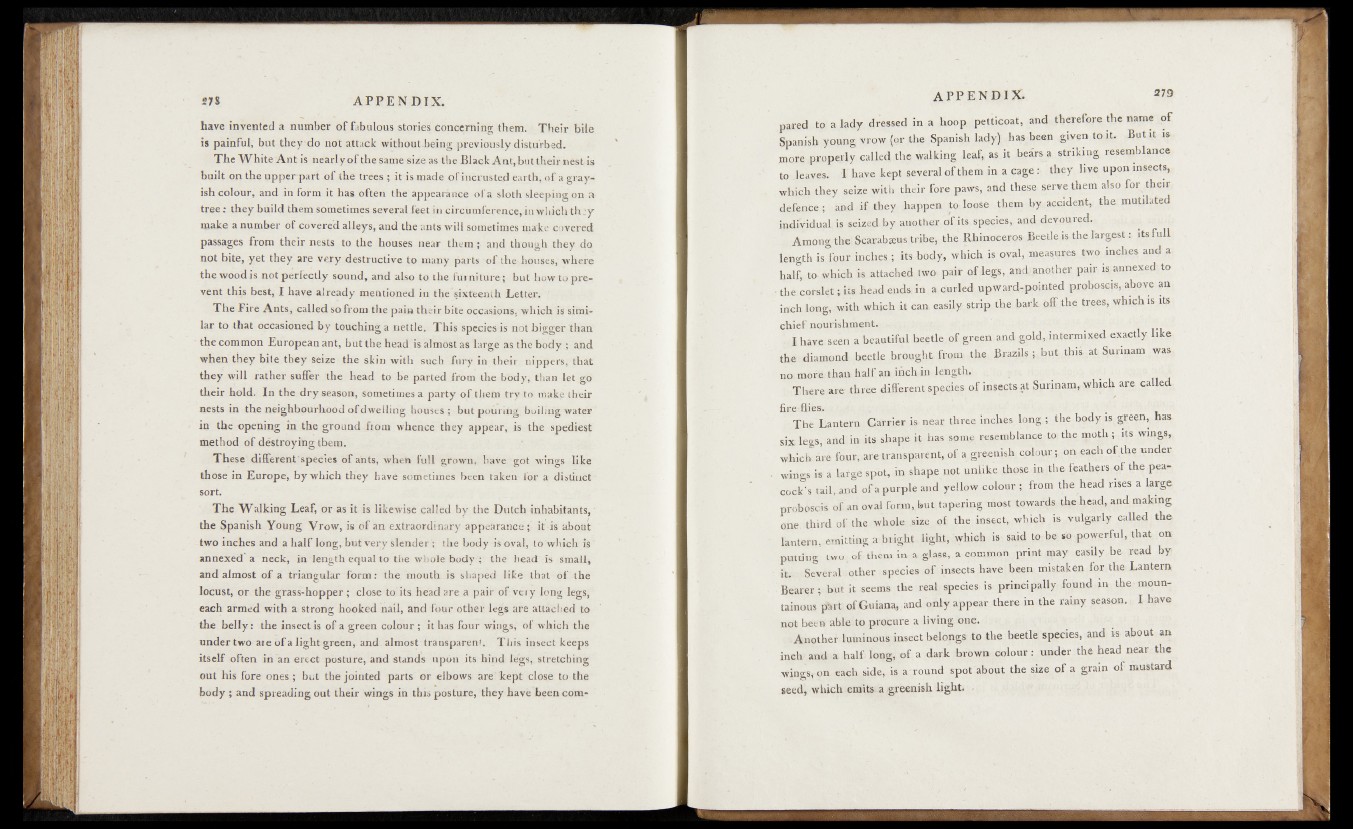
have invented a number o f fabulous stories Concerning them. Their bile
is painful, but they*do not attack withouthëingpreviously disturbed.
The W hite Ant is nearlyof the same size as the Black Anfbu.t their nestis
built on the upperparf o f the trees; it is made ofincrusted earth, of a grayish
colour, and in form it has often the appearance of a sloth sleeping on a-
tree: they build them sometimes several feet m _cireüm&rëoce,in winch they
make a number of covered alleys, and the ants will sometimes make covered
passages from their nests to the houses near them ; ar)d though they do
not bite, -yet they are -very destructive to many parts of the-houses, where
the wood is not perfectly sound, and also to the furniture; but how to prevent
thfe best, I have already mentioned in the sixteenth Letter, '
The Fire Ants, called so from the pain their bite occasions, which is similar
to that occasioned by touching a nettle.- This speciesis not Bigger than
the common European ant, but the head is almost as large as the body ; and
when they bile they seize the skin with such fury in their nippers, that
they will rather suffer the head to be parted jrom the body, thaa fetigo
their hold. In the dry season, sometimes a party o f them try to make their
«ests in the neighbourhood ofdwelling houses ; but pouring, boiling water
in the opening m the ground fiom whence they appear, is the spediest
method of destroying tbem.
These different species of ants, when full grown, have got wings like
those in Europe, by which they have sometimes been taken fof a distinct-
sort.
The Walking Leaf, or as it is likewise called by the Dutch inhabitants,'
the Spanish Young Yrow, is df an extraordinary appearance itr-is about
two inches and a half long, but very slender; the body is oval, tp which is'
annexed a neck, in length equal to the whole body f the head is small,
and almost of a triangular form: the mouth is shaped like that óf the
locust, or the.grass-hopper; close touts head are a pair of Very long legs,
each armed with a strong hooked nail, and four other legs are attached to
die belly: the insect!^ of a green colour ; it has four wings,* of which the
under two are of a light green, and. almost transparem. This insect keeps
itself often in an erect posture, and stands upon its hind legs, stretching
out his fore ones.; but the jointed parts or elbows are." kept close to the
body; and spreading out their wings in this posture, they havé been compared
to a lady dressed in a ,hoop petticoat, and therefore the name pf
Spamsh’yp o n S v r ow V dm Spanish lady} has been given toit. -Bptit is
more .properly called the talking leaf, as it heirs a strikiug resemblance
to .leaves. T have kept several oftfeem in a cage: they live upon insects,
which they seize with their fore paws, and these; serve them also for their
defente; and i f .they? happen to, loose them b y accident, the, mutilated
individual is seized by another o f its,spj?eie§„ and devoured. , c
. Among the Scarabffius .tribe, the Rhinoceros. Beetle^, the largest-: its full
l e n g t h is./ b u r .fochgs ; its body, which ,^ ’Qyal, measures two inches and a
half, to which is -attached two- pair o f legs, and^notheypair- % annexed to
, the,corslet; its head ends in sa ^ e d . .upward-pointed above an
inch long, .with which it can. easily strip, thw a ck pffthp trees, which is its
■ I have.seert a beautiful beetle,pf green and gold, intermixed, exactly like
the diamond Beetle brought, from* the Brazes; bufthis -at; Sunpam was.
no more, thau half an inch in length* .1 pr« i ; ^ arl .
There-are three different species of insects ^t Surinam, which are called .
Tups, ' ■ ■' ....' HBJp* 1
The Lantern Carrier is. near three inches. long ; the body is green, has
sixlegs, and in its shape it has some resemblance tq tlie moth; its wings,
whiefoare four, are transparent* of a greenish colour;, on each of the under
- wings is a large spot, in shape not unlike those in the feathers o f the peacock's
t a i l e d ofa purple and yellow colota; from the head Vises a largo
probosciS o f an oval foran,, but tapering'most towards the head, and making
one third of- the whole size of the inseqt, which. is vulgarly called the
lantern, emitting mbidght- light, which js said to be so powerful, that on
putting two, o f them in a glass, a common print may easily be read by;
i f . SevetalKQther - species o f insects have been mistaken for the Lantern
Bearer ; but it seems the real; species- is principallyrfouod-m the1 mountainous
pVt of Guiana, and only appear there In the rainy season. I have
not been ableitp procure a living, ione. : - ; | ■ - -
-Another luminous insect helongs? to the beetle species, and is- about an
inch and a half tong, of a dark brown colour: under the head near the
wingsr on each.side, is a round spot about the size of a grain of mustard
seed, which emits a greenish light. .